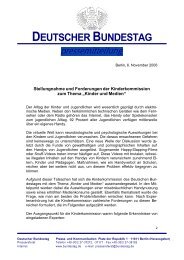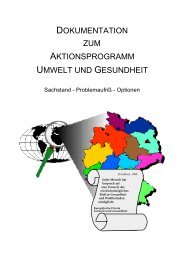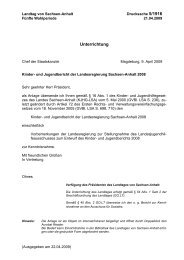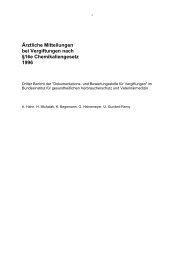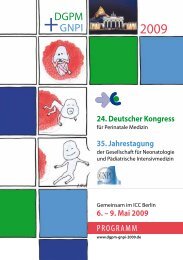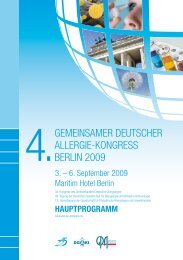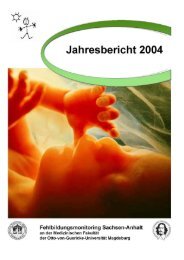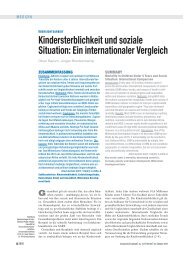- Seite 1 und 2:
Texte 02 09 ISSN 1862-4804 Untersuc
- Seite 3 und 4:
Diese Publikation ist ausschließli
- Seite 5 und 6:
1. Report No. UBA-FB 001229 4. Repo
- Seite 7 und 8:
Umweltmykologie GbR Berlin) 2.3.6.2
- Seite 9 und 10:
3.3.3.1 Vorversuche zur Freisetzung
- Seite 11 und 12:
• Festlegung der morphologischen
- Seite 13 und 14:
Seitens des Umweltbundesamtes wurde
- Seite 15 und 16:
Mikroorganismen, wie z.B. Saccharop
- Seite 17 und 18:
Weiterhin wurde im Staub einer Kind
- Seite 19 und 20:
eines gemeinsamen Trainings wurde s
- Seite 21 und 22:
auswählt. In der Vorphase (bis zur
- Seite 23 und 24:
auf wissenschaftlichen Tagungen üb
- Seite 25 und 26:
Die Auswahl der Parameter entsprich
- Seite 27 und 28:
2.2 Beschreibung der Probenahmestel
- Seite 29 und 30:
Es sollten auch mittels Datenlogger
- Seite 31 und 32:
Farbe ist zum einen für die Gewinn
- Seite 33 und 34:
2.3.2 Nährmedien zur Kultivierung
- Seite 35 und 36:
2.3.4 Festlegung der Dominanz einze
- Seite 37 und 38:
2.3.5.3 Gram-Färbung Die Gram-Fär
- Seite 39 und 40:
Die DC-Platte wurde anschließend i
- Seite 41 und 42:
Für die Analyse der Fettsäuren er
- Seite 43 und 44:
2.3.6 Konservierung Die Konservieru
- Seite 45 und 46:
eingewogen und etwas Zellmateriall
- Seite 47 und 48:
2.4.1.3 DNA-Extraktion aus Kolonien
- Seite 49 und 50:
Plasmid-Primer M13 Primer 616 V / 1
- Seite 51 und 52:
Universelle 16S rRNA Primer (EUB-Pr
- Seite 53 und 54:
2.4.2.2 Agarosegelelektrophorese Di
- Seite 55 und 56:
gemischt. Das Gemisch wurde zwei mi
- Seite 57 und 58:
Alle Schritte der Silbernitratfärb
- Seite 59 und 60:
Fragmente mit einem A-Überhang rel
- Seite 61 und 62:
2.4.5 Sequenzierung durch Kettenabb
- Seite 63 und 64:
Der MTT-Zellkulturtest zeichnet sic
- Seite 65 und 66:
Probenmaterials sicher ausgeschloss
- Seite 67 und 68:
Untersuchungsobjekte isoliert worde
- Seite 69 und 70:
3 Ergebnisse 3.1 Kultivierungsabhä
- Seite 71 und 72:
Tab. 9: Koloniebildende Einheiten (
- Seite 73 und 74:
Tab. 10: Gattungszuordung der gewon
- Seite 75 und 76:
3.1.2.2 Übersicht über die häufi
- Seite 77 und 78:
In den Proben wurden jeweils 4 bzw.
- Seite 79 und 80:
in den 24 untersuchten Proben (die
- Seite 81 und 82:
In der Abb. 3 sind die Anteile der
- Seite 83 und 84:
[Σ Gattungen] 25 20 15 10 5 0 WP 0
- Seite 85 und 86:
Weiterhin bildeten einige Referenzi
- Seite 87 und 88:
ähnliches Spektrum unterschiedlich
- Seite 89 und 90:
Abb. 6: Referenzisolate der Gattung
- Seite 91 und 92:
auf Hafermehl-, Gauze- und CASO-Aga
- Seite 93 und 94:
Abb. 8: Koloniemorphologie der Refe
- Seite 95 und 96:
3.1.2.5.2 Micromonospora Aus der Ga
- Seite 97 und 98:
Abb. 15: Koloniemorphologien von 14
- Seite 99 und 100:
3.1.2.5.5 Nocardiopsis Die Mehrzahl
- Seite 101 und 102:
Abb. 25: 21 Tage alte Referenzisola
- Seite 103 und 104:
Abb. 28: Abb. 29: Kleine Kulturen v
- Seite 105 und 106:
Abb. 31: Kolonien (von unten aufgen
- Seite 107 und 108:
Abb. 33: Abbildung der Luftmyzelien
- Seite 109 und 110:
3.1.2.5.8 Saccharopolyspora Die Meh
- Seite 111 und 112:
Abb. 39: Abb. 40: Streptomycetes-Ko
- Seite 113 und 114:
Eine sichere Bestimmung auf der Pri
- Seite 115 und 116:
3.1.4 Chemotaxonomische Untersuchun
- Seite 117 und 118:
Die Identifizierung eines dieser 4
- Seite 119 und 120:
Tab18: Chemotaxonomische Merkmale d
- Seite 121 und 122:
Tab. 19: Chemotaxonomische Merkmale
- Seite 123 und 124:
Tab. 20: Chemotaxonomische Merkmale
- Seite 125 und 126: Saccharothrix, Propionibacterium, P
- Seite 127 und 128: 3.2.2 SSCP (Singel Strand Conformat
- Seite 129 und 130: Korrelation mit Hilfe einer Cluster
- Seite 131 und 132: Tab. 22: Referenzkonzentrationen vo
- Seite 133 und 134: angenommen (das gesamte Wachstum au
- Seite 135 und 136: Freisetzung von TNF-α in Abhängig
- Seite 137 und 138: ml. Dies deutet an, dass die Interl
- Seite 139 und 140: dieser Probe wurden nicht untersuch
- Seite 141 und 142: Erhöhung der TNF-alpha Freisetzung
- Seite 143 und 144: 4 Diskussion 4.1 Ergebnisse und Sch
- Seite 145 und 146: Anzüchtung einzelner Isolate auf v
- Seite 147 und 148: molekularbiologischen Methoden für
- Seite 149 und 150: Nocardioidaceae detektiert werden.
- Seite 151 und 152: 4.3.1 Molekularbiologische Identifi
- Seite 153 und 154: In der vorliegenden Studie wurden n
- Seite 155 und 156: Eine weitere Gattung, deren Vertret
- Seite 157 und 158: Actinomycetales besitzen L-Lysin, L
- Seite 159 und 160: PII PIM, PI, (PG), PE, DPG PIII (PI
- Seite 161 und 162: Pseudonocardia Pseudonocardiaceae m
- Seite 163 und 164: durchgeführt. Auch wenn mit beiden
- Seite 165 und 166: 4.5 Diskussion der toxikologischen
- Seite 167 und 168: Nocardiopsis. Dies zeigt, dass man
- Seite 169 und 170: 4.5.3 Diskussion - Gesundheitliche
- Seite 171 und 172: 4.6 Zusammenfassung Diversität: Di
- Seite 173 und 174: Allein anhand koloniemorphologische
- Seite 175: 4.6 Summary Diversity The results o
- Seite 179 und 180: Verzeichnis der Abbildungen Abb. 1:
- Seite 181 und 182: Verzeichnis der Tabellen Tab. 1: De
- Seite 183 und 184: Ensign, J.C. (1992): Introduction t
- Seite 185 und 186: Kutzner, H. J, Kempf, A. (1996): Vo
- Seite 187 und 188: Rintala, H., Pitkäranta, M., Toivo
- Seite 189 und 190: Anhang: Probendatenblätter Probend
- Seite 191 und 192: Objektbeschreibung Probendatenblatt
- Seite 193 und 194: Objektbeschreibung Probendatenblatt
- Seite 195 und 196: Objektbeschreibung Probendatenblatt
- Seite 197 und 198: Objektbeschreibung Probendatenblatt
- Seite 199 und 200: Objektbeschreibung Probendatenblatt
- Seite 201 und 202: Objekt 05 (Bad) Ergebnisse Feuchtig
- Seite 203 und 204: Objektbeschreibung Probendatenblatt
- Seite 205 und 206: Objektbeschreibung Probendatenblatt
- Seite 207 und 208: Probe 09 02-07/02 1 Filter 09.03.06
- Seite 209 und 210: Ergebnisse Feuchtigkeits- und Tempe
- Seite 211 und 212: pH-Wert Probe Nr. Material elektron
- Seite 213 und 214: Probe 12 06-07/02 (je 80 g) LGA 18.
- Seite 215 und 216: Ergebnisse Feuchtigkeits- und Tempe
- Seite 217 und 218: Versand an Probe 14 08-07/01 22.08.
- Seite 219 und 220: Versand an Probe 15 08-07/01 22.08.
- Seite 221 und 222: Probenahme Nr. Material Datum/Bearb
- Seite 223 und 224: Mikroskopie Zellform Stäb.-Kokken-
- Seite 225 und 226: 7 Agar 15,0 g 8 Aqua dest. 1000 ml
- Seite 227 und 228:
Glucose-Yeast-Malt-Agar (GYM STREPT
- Seite 229 und 230:
Tab. A 1: API-ZYM-Test Isolat Agar
- Seite 231 und 232:
Agrococcus ca. 1200 bp 0.01 53 228
- Seite 233 und 234:
Arthrobacter, ca. 1260 bp, outgroup
- Seite 235 und 236:
Brevibacterium ca. 1330 bp 0.01 84
- Seite 237 und 238:
Corynebacterium Teil des phylogenet
- Seite 239 und 240:
Janibacter ca. 1400 bp outgroup Orn
- Seite 241 und 242:
Kocuria, ca. 1330 bp, outgroup Arth
- Seite 243 und 244:
Kytococcus, ca. 1340 bp outgroup Br
- Seite 245 und 246:
Leucobacter ca. 1360 bp 0.005 64 93
- Seite 247 und 248:
Micrococcus, ca. 1350 bp, outgroup
- Seite 249 und 250:
Micromonospora, ca. 1320 bp, outgro
- Seite 251 und 252:
Nocardia, ca. 1280 bp, outgroup Mic
- Seite 253 und 254:
Nocardiopsis, ca1300 bp, outgroup A
- Seite 255 und 256:
Ornithinimicrobium /Arsenicicoccus,
- Seite 257 und 258:
Promicomonospora, 1230 bp (14 Isola
- Seite 259 und 260:
Rhodococcus, ca. 1230 bp, outgroup
- Seite 261 und 262:
Tsukamurella, ca. 1400 bp, outgroup
- Seite 263 und 264:
Nährmedium Dominanzklasse Putzprob
- Seite 265 und 266:
Nährmedium Dominanz Styroporprobe
- Seite 267 und 268:
Nährmedium Dominanzklasse Lehmputz
- Seite 269 und 270:
Stammnummer KBE/g bzw. m 3 DAP Iden
- Seite 271 und 272:
Stammnummer KBE/g bzw. m 3 DAP Iden
- Seite 273 und 274:
Stammnummer KBE/g bzw. m 3 DAP Iden
- Seite 275 und 276:
Stammnummer KBE/g bzw. m 3 DAP Iden
- Seite 277 und 278:
Stammnummer KBE/g bzw. m 3 DAP Iden
- Seite 279:
Stammnummer KBE/g bzw. m 3 DAP Iden



